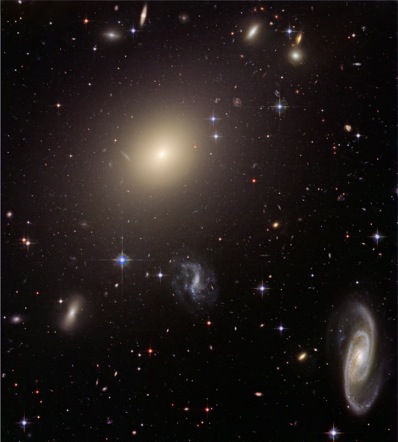



|

|

Massive galaxies reigned in growth 7 billion years ago
KEITH COOPER
ASTRONOMY NOW
Posted: 19 April 2011


Evidence that the biggest galaxies in the Universe had halted their growth by the time the cosmos was half its current age is confounding our models of galaxy formation, according to new results revealed at the Royal Astronomical Society’s National Astronomy Meeting in Llandudno, Wales.
Claire Burke and Professor Chris Collins from Liverpool John Moores University, and Dr John Stott at Durham University and formerly of Liverpool John Moores, used archival data from the Hubble Space Telescope to look at so called brightest cluster galaxies (BCGs) – the most massive, most luminous elliptical galaxies with masses measuring up to 100 trillion times the Sun, and located in the hearts of galaxy clusters.

The giant brightest cluster galaxy ESO 325-G004 in the galaxy cluster Abell S740, which is 450 million light years away. Image: NASA/ESA/Hubble Heritage Team (STScI/AURA).
The hierarchical theory of galaxy formation describes how galaxies grow through mergers with smaller galaxies, and this process predicts that the most massive galaxies should have formed more recently. Instead, the team found that BCGs stopped growing about seven billion years ago (about halfway back to the big bang) based on comparing their size and mass then, and the size and mass of BCGs such as M87 today. In the intervening time, according to traditional hierarchical theory, the BCGs should have tripled in mass, but the team could find no clear evidence of any mass or size increase at all.
Is there a reason why BCGs are growing so fast early in the Universe only for their evolution to stumble to a crawl, and does this place the hierarchical model into jeopardy? The evidence is that BCGs still form, at least partly, through mergers with other galaxies – clusters are crowded places and mergers are inevitable – but this hierarchical process may be accelerated in clusters so that most of the action was over by seven billion years ago. Another method by which BCGs could form, say Stott and Burke, is by a phenomenon called ‘cold streaming’. At the largest scales the Universe is filled with a cosmic web of matter, at the nodes of which are the galaxy clusters. Cold hydrogen gas streaming along the filaments of the web pour into the clusters, and the fact that they are cold is important – cold gas only a few degrees above absolute zero is required to condense into stars. Gas in clusters can quickly become heated to many millions of degrees, which can call an immediate halt to further galaxy growth.
The formation processes of BCGs is independent of normal galaxies ‘in the field’ like our own Milky Way, which are still believed to grow according to the standard hierarchical model. However, this new research indicates that how galaxies form may vary depending upon their environment, and that many large structures in the Universe formed much more rapidly than we realised.
|

|

|

|
|



